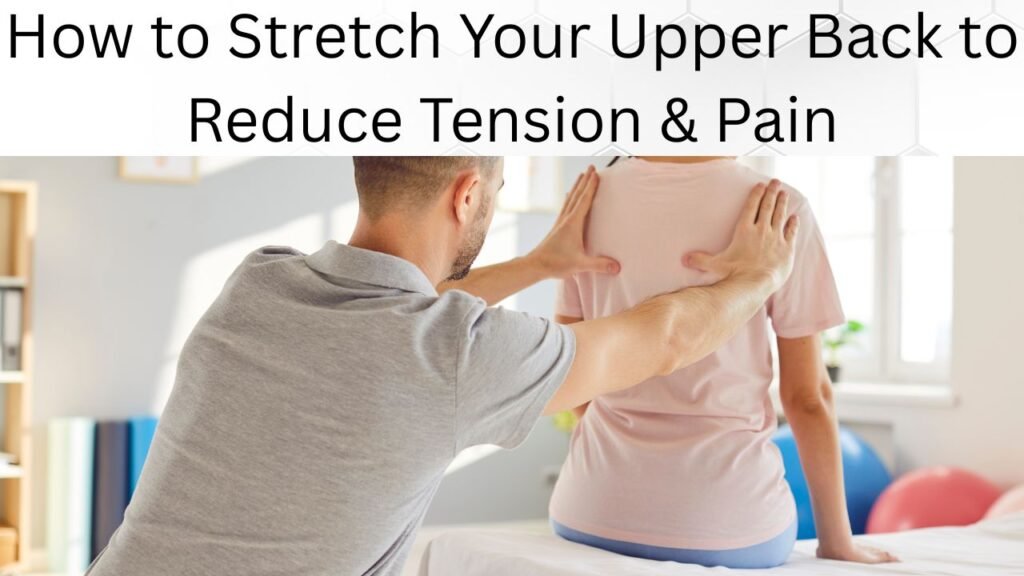Upper back tension is a common issue, often caused by poor posture, prolonged sitting, or stress. Stiffness in this area can lead to discomfort, reduced mobility, and even headaches. Regular stretching helps alleviate pain, improve flexibility, and prevent chronic stiffness. Below is a guide to the most effective upper back stretches for reducing tension and enhancing mobility.

Understanding Upper Back Tension
The upper back, or thoracic spine, consists of the shoulder blades, trapezius, and rhomboid muscles. Tightness in this region can stem from slouching, repetitive movements, or muscular imbalances. Stretching these muscles increases blood flow, releases built-up tension, and promotes better posture.
Best Stretches to Relieve Upper Back Pain
1. Seated Forward Bend Stretch
A simple yet effective stretch to release tightness in the upper back.
How to Do It:
- Sit in a chair with feet flat on the floor.
- Clasp your hands together and stretch forward, rounding your upper back.
- Hold for 20-30 seconds while taking deep breaths.
Why It Helps: This stretch lengthens the upper back muscles and relieves built-up tension from prolonged sitting.
2. Cross-Body Shoulder Stretch
Targets the shoulder and upper back muscles that become tight due to poor posture.
How to Do It:
- Stand tall and bring one arm across your chest.
- Use your opposite hand to gently press the arm closer.
- Hold for 20-30 seconds, then switch sides.
Why It Helps: It improves shoulder mobility and reduces stiffness in the upper back.
3. Cat-Cow Stretch
A dynamic movement that enhances spinal mobility and reduces upper back tension.
How to Do It:
- Get on all fours with wrists under shoulders and knees under hips.
- Inhale, arch your back, lifting your chest and tailbone (Cow Pose).
- Exhale, round your spine, tucking your chin (Cat Pose).
- Repeat for 1-2 minutes.
Why It Helps: It loosens tight muscles and increases circulation to the spine.
4. Thread the Needle Stretch
A deep rotational stretch for the upper back and shoulders.
How to Do It:
- Get on all fours and extend one arm under your body, resting your shoulder and head on the ground.
- Hold for 20-30 seconds, then switch sides.
Why It Helps: It releases deep-seated tension in the upper back and improves spinal flexibility.
5. Wall Angels
This stretch promotes better posture and opens up tight upper back muscles.
How to Do It:
- Stand with your back against a wall and arms in a goalpost position.
- Slowly raise and lower your arms while keeping them against the wall.
- Repeat for 10-15 reps.
Why It Helps: It strengthens postural muscles while reducing upper back strain.
6. Child’s Pose with Arm Extension
A gentle stretch that lengthens the spine and relaxes the upper back.
How to Do It:
- Sit on your heels and extend your arms forward on the floor.
- Press your chest downward while keeping arms extended.
- Hold for 30 seconds.
Why It Helps: It relieves upper back tightness and promotes relaxation.
7. Doorway Stretch
A great way to stretch the chest and upper back simultaneously.
How to Do It:
- Stand in a doorway with arms bent at 90 degrees against the frame.
- Step forward slightly, feeling a stretch across the chest and upper back.
- Hold for 20-30 seconds.
Why It Helps: It counteracts forward shoulder posture, which contributes to upper back pain.
Additional Tips for Preventing Upper Back Tension
- Improve Posture: Maintain an upright sitting and standing position to reduce strain on the upper back.
- Take Frequent Breaks: Avoid prolonged sitting by standing and stretching every 30-60 minutes.
- Strengthen Supporting Muscles: Perform exercises that target the upper back and shoulders to improve stability.
- Practice Deep Breathing: Stress contributes to tension; deep breathing helps relax the muscles.
- Stay Hydrated: Proper hydration supports muscle flexibility and reduces stiffness.
When to Seek Medical Advice
If upper back pain persists, worsens, or is accompanied by numbness, tingling, or radiating pain, consult a healthcare provider. Persistent discomfort may indicate an underlying issue such as a herniated disc or nerve compression.
Final Thoughts
Stretching your upper back regularly reduces tension, improves mobility, and prevents discomfort. By incorporating these stretches into your daily routine, you can maintain better posture and avoid chronic stiffness. Prioritize movement and consistency for long-term upper back health.